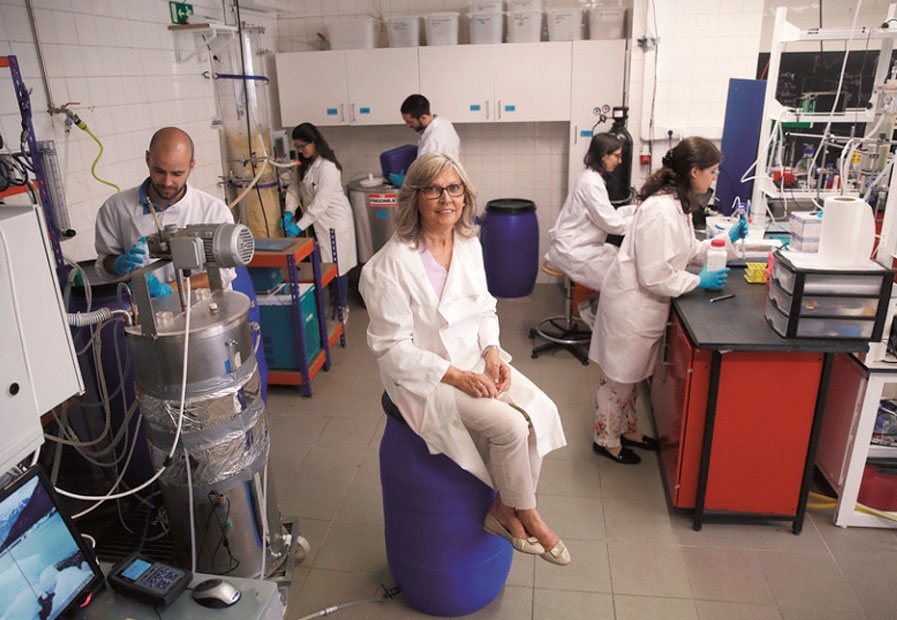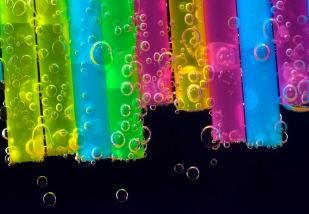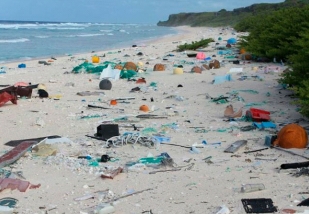NEWS
We transform, develop and market flexible plastic packaging
The scientists who puts bacteria manufacturing biodegradable plastic
4 | August | 2017
Maria Reis and her team at the laboratory where the bacteria produce plastic polymers in the bioreactor at the left
Maria Reis creates two to three kilos of plastic per week from food industry waste. Bacteria are the oldest living beings on Earth and probably the most numerous ones, but we continue learning from them. This time in the prevention of a plague that is spreading across seas and continents: plastic waste.
Maria Reis, a professor at the Faculty of Science and Technology (FCT) at the Universidade Nova de Lisboa, leads a team of 36 researchers and technicians - the Bioeng Group - in the Department of Chemistry (at the UCIBIO unit) who are transforming bacteria, unicellular microorganisms, in authentic plastic factories. But the material produced has a radical difference from the one which pollutes nature: it is biodegradable, decomposing into water and carbon dioxide after three to four weeks, instead of the hundreds of years that scientists estimate for the decomposition of conventional plastics, made from petroleum.
What is most surprising is that these bacteria produce plastic from waste that would otherwise have to be treated or incinerated with high costs. Bacteria consume whey, residues of fruit concentrates, sludge from Wastewater Treatment Plants (WWTP) and municipal solid waste. Inside them or on their walls are then formed polymers, that are, agglomerates of molecules. Or they are simply expelled.
The waste is placed in bioreactors, closed containers where there are chemical reactions involving the bacteria, which then produce biopolymers. Those that form inside (intracellular) the bacteria are known by an extensive, complicated and difficult to fix name: Polyhidoxyalkanoates (PHA).
“MODE OF HUNGER AND PLENTY ”
“PHAs are in great demand on the market because they are similar to conventional plastics in mechanical and chemical properties,” explains Maria Reis. “We have been working for more than 15 years in this field, where we are pioneers worldwide. And we were able to obtain them because we used mixed cultures, essentially of various types of bacteria, which we adapted to the experimental conditions so that they produced the plastic. ”.
Bioreactors operate through a curious selective process known as “hunger mode and plenty”. As the researcher points out, cthere are two feeding cycles per day: we feed the bacteria with waste for one hour - the period of plenty - and then go through a period of starvation of 10 to 11 hours. So when we feed them again, they consume the waste to prevent future hunger and internally produce polymers. ”.
There is a physiological adaptation of bacteria “and only within the bioreactor are those that survive to starve and produce polymers”. The others leave the bioreactor and die. The results obtained by the Bioeng Group are impressive. “We have already achieved that 70 to 80 percent of the weight of each cell is polymer,” says Maria Reis. “The rest is protein, water, and cellular material.” Then each cell must be cleaved to extract the polymers, using for example bleach, which does not affect them because they do not dissolve in aqueous medium. “The so-called proof of concept is done through a pilot facility where we produce two to three pounds per week from food industry waste. ”.
The biopolymers formed in the cell walls are obtained through the yeast Komagataella pastoris. And those excreted by (extracellular) cells are called exopolysaccharides and are produced by the bacterium Enterobacter A47 after being fed with glycerol, a by-product of biodiesel, or other food waste. The two types of biopolymers are protected by several international patents and can be used in the cosmetics, pharmaceutical and food industries.
But after all, why are biodegradable plastics not invading the market? “Because they cost five to ten times more than conventional plastics,” argues the FCT professor. “One of the goals of our work is precisely to reduce the cost of the new product to less than double the conventional product, but with the advantage of being biodegradable, which means that there is no waste treatment costs generated by conventional plastics.” And this is where the EU is investing, “in more economically and socially sustainable processes. ”
Maria Reis' team is involved in several European projects, which integrate institutions from other EU countries. But the total funding allocated to the Bioeng Group for its participation amounts to around three million euros over three years. “The invitations to these projects have arisen because our group is recognized at international level,” says the researcher. “These are projects that are based on the use of waste and the concept of circular economy. Their goal is to treat these wastes and create value from them, which means that they become raw materials. ”.
CIRCULAR ECONOMY
According to the Business Council for Sustainable Development (BCSD Portugal), the circular economy is the transition from the linear model of production of goods and services to a circular model, where waste is transformed, through innovation, into other materials that allow recycling and reuse. The circular model assumes that products and services originate in ecosystems and that, at the end of their useful life, they return to nature through waste with very low environmental impact. “Everything that is produced is recovered,” says Maria Reis. The world economy, however, has been dominated by a linear business model, in which more resources are consumed than those that the Earth can replenish. And in which the raw materials are extracted and processed into products that are sold and, after use, discarded as waste.
Maria Reis creates two to three kilos of plastic per week from food industry waste. Bacteria are the oldest living beings on Earth and probably the most numerous ones, but we continue learning from them. This time in the prevention of a plague that is spreading across seas and continents: plastic waste.
Maria Reis, a professor at the Faculty of Science and Technology (FCT) at the Universidade Nova de Lisboa, leads a team of 36 researchers and technicians - the Bioeng Group - in the Department of Chemistry (at the UCIBIO unit) who are transforming bacteria, unicellular microorganisms, in authentic plastic factories. But the material produced has a radical difference from the one which pollutes nature: it is biodegradable, decomposing into water and carbon dioxide after three to four weeks, instead of the hundreds of years that scientists estimate for the decomposition of conventional plastics, made from petroleum.
What is most surprising is that these bacteria produce plastic from waste that would otherwise have to be treated or incinerated with high costs. Bacteria consume whey, residues of fruit concentrates, sludge from Wastewater Treatment Plants (WWTP) and municipal solid waste. Inside them or on their walls are then formed polymers, that are, agglomerates of molecules. Or they are simply expelled.
The waste is placed in bioreactors, closed containers where there are chemical reactions involving the bacteria, which then produce biopolymers. Those that form inside (intracellular) the bacteria are known by an extensive, complicated and difficult to fix name: Polyhidoxyalkanoates (PHA).
“MODE OF HUNGER AND PLENTY ”
“PHAs are in great demand on the market because they are similar to conventional plastics in mechanical and chemical properties,” explains Maria Reis. “We have been working for more than 15 years in this field, where we are pioneers worldwide. And we were able to obtain them because we used mixed cultures, essentially of various types of bacteria, which we adapted to the experimental conditions so that they produced the plastic. ”.
Bioreactors operate through a curious selective process known as “hunger mode and plenty”. As the researcher points out, cthere are two feeding cycles per day: we feed the bacteria with waste for one hour - the period of plenty - and then go through a period of starvation of 10 to 11 hours. So when we feed them again, they consume the waste to prevent future hunger and internally produce polymers. ”.
There is a physiological adaptation of bacteria “and only within the bioreactor are those that survive to starve and produce polymers”. The others leave the bioreactor and die. The results obtained by the Bioeng Group are impressive. “We have already achieved that 70 to 80 percent of the weight of each cell is polymer,” says Maria Reis. “The rest is protein, water, and cellular material.” Then each cell must be cleaved to extract the polymers, using for example bleach, which does not affect them because they do not dissolve in aqueous medium. “The so-called proof of concept is done through a pilot facility where we produce two to three pounds per week from food industry waste. ”.
The biopolymers formed in the cell walls are obtained through the yeast Komagataella pastoris. And those excreted by (extracellular) cells are called exopolysaccharides and are produced by the bacterium Enterobacter A47 after being fed with glycerol, a by-product of biodiesel, or other food waste. The two types of biopolymers are protected by several international patents and can be used in the cosmetics, pharmaceutical and food industries.
But after all, why are biodegradable plastics not invading the market? “Because they cost five to ten times more than conventional plastics,” argues the FCT professor. “One of the goals of our work is precisely to reduce the cost of the new product to less than double the conventional product, but with the advantage of being biodegradable, which means that there is no waste treatment costs generated by conventional plastics.” And this is where the EU is investing, “in more economically and socially sustainable processes. ”
Maria Reis' team is involved in several European projects, which integrate institutions from other EU countries. But the total funding allocated to the Bioeng Group for its participation amounts to around three million euros over three years. “The invitations to these projects have arisen because our group is recognized at international level,” says the researcher. “These are projects that are based on the use of waste and the concept of circular economy. Their goal is to treat these wastes and create value from them, which means that they become raw materials. ”.
CIRCULAR ECONOMY
According to the Business Council for Sustainable Development (BCSD Portugal), the circular economy is the transition from the linear model of production of goods and services to a circular model, where waste is transformed, through innovation, into other materials that allow recycling and reuse. The circular model assumes that products and services originate in ecosystems and that, at the end of their useful life, they return to nature through waste with very low environmental impact. “Everything that is produced is recovered,” says Maria Reis. The world economy, however, has been dominated by a linear business model, in which more resources are consumed than those that the Earth can replenish. And in which the raw materials are extracted and processed into products that are sold and, after use, discarded as waste.












